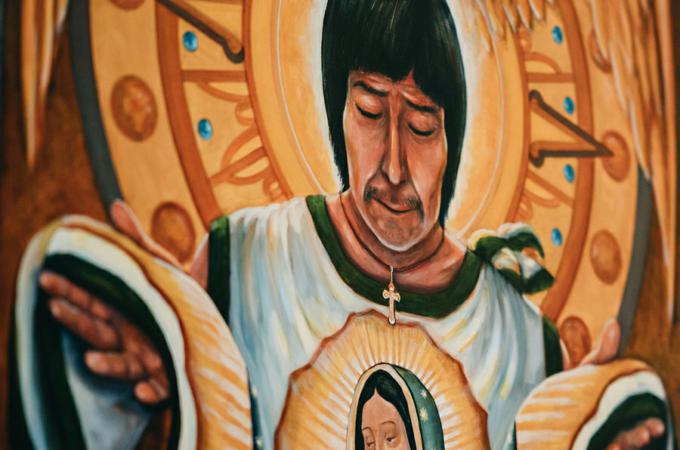'Non Fecit Taliter Omni Nationi'
The second most popular pilgrimage site in the world for Catholics used to be San Giovanni Rotondo in Italy, the town of Padre Pio, on the Adriatic Coast of Italy, across from Rome. It's hard to measure the immense popularity of this great saint. In the saint's monastery, there is a room about 15 by 20 feet, with a few tables and some desks. The room is lined on all four walls with closely packed shelves about five inches high. Perhaps you remember those thin blue airmail letters, made so thin, like onion skin, to save weight? Well, the shelves in that room are filled and packed tightly, all around, with airmail letters like that, sent to Padre Pio, to ask for advice and prayers. It was in this room that a small army of fellow monks would read and answer those letters. An astonishing sight. Imagine that he received so many letters in his lifetime! Actually, no -- the tour guide explained -- that room contained only the letters he received in a single year.
I like to tell this story to friends and then ask them what the first most popular pilgrimage site for Catholics is. It's not Lourdes or Rome. Rather, it is what locals call "La Villa," the church in Mexico City, where the tilma of Juan Diego is displayed, beside the hill of Tepeyac, where the Virgin Mother taking the name "Guadalupe" appeared to a simple Aztec, Juan Diego Cuauhtlatoatzin, in 1531, and imprinted an image of herself on that tilma. Those appearances and that miraculous image made Mexico the great Catholic country it has been over the centuries, since millions of indigenous people converted to Christianity in the aftermath. In churches all throughout Mexico, commemorating the event, one can see stained-glass windows with images of the Guadalupe, having the inscription, "Non fecit taliter omni nationi." It's a line from Psalm 147, "He has not dealt thus with any other nation." Yes, those are serious bragging rights.
The fact that La Villa is in the middle of a city of about 40 million helps to explain why it is the most popular pilgrimage site. One would like to say that proximity of Americans, who have the means to make the pilgrimage, has something to do with it as well. And yet, I have found, in my experience, that few have made the trip. It's not a priority. Getting to the Grand Canyon or Hawaii will be placed much higher. Actually, La Villa is rarely even on someone's list.
A tilma is a simple garment, like a tunic, which the poorest Aztecs would wear, of fairly rough fabric, woven out of cactus fibers. They say that such material typically decomposes in about 20 years. But the tilma of Juan Diego is still with us and apparently in pristine condition, more than 400 years later. The image of Our Lady impressed upon it is startlingly real. It has lively natural colors, but not gaudy colors. The image has been studied carefully by scientists and artists, and no one can say how it was produced. There are no signs of brush marks or pigments. It's as if the fabric itself became colored.
It was the great Pope John Paul II, who, on Jan. 23, 1999, named Our Lady of Guadalupe the Patroness of the Americas and made her feast a solemnity for us; that is, the equivalent liturgically of the Immaculate Conception. Note the date: it closely coincided with the anniversary of Roe v. Wade, the Supreme Court's decision removing all legal protection of unborn children. This was not by accident, as early on it was noticed that Our Lady of Guadalupe is an image, precisely, of mother with child, as the Virgin in that image wears a traditional band, which signifies a pregnant condition in the Aztec culture. "Dear brothers and sisters, the time has come to banish once and for all from the continent every attack against life," that great pope said, presumably with the attack of abortion foremost in his mind. But mark how he continued:
"No more violence, terrorism and drug-trafficking! No more torture or other forms of abuse! There must be an end to the unnecessary recourse to the death penalty! No more exploitation of the weak, racial discrimination or ghettoes of poverty! Never again! These are intolerable evils that cry out to heaven and call Christians to a different way of living, to a social commitment more in keeping with their faith. We must rouse the consciences of men and women with the Gospel, in order to highlight their sublime vocation as children of God. This will inspire them to build a better America. As a matter of urgency, we must stir up a new springtime of holiness on the continent so that action and contemplation will go hand in hand."
Prayer is here joined with action; social commitment with evangelization; North Americans joined with Mexicans. One might well take this checklist along on a pilgrimage there.
It can seem so far away. But let's renew the saintly pope's aspiration: "Holy Virgin of Guadalupe, Queen of Peace! Save the nations and peoples of this continent. Teach everyone, political leaders and citizens, to live in true freedom and to act according to the requirements of justice and respect for human rights, so that peace may thus be established once and for all."
- Michael Pakaluk, an Aristotle scholar and Ordinarius of the Pontifical Academy of St. Thomas Aquinas, is a professor in the Busch School of Business at the Catholic University of America. He lives in Hyattsville, MD, with his wife Catherine, also a professor at the Busch School, and their eight children. His latest book, on the Gospel of Mark, is "The Memoirs of St Peter." His next book,"Mary's Voice in the Gospel of John," is forthcoming from Regnery Gateway.



















